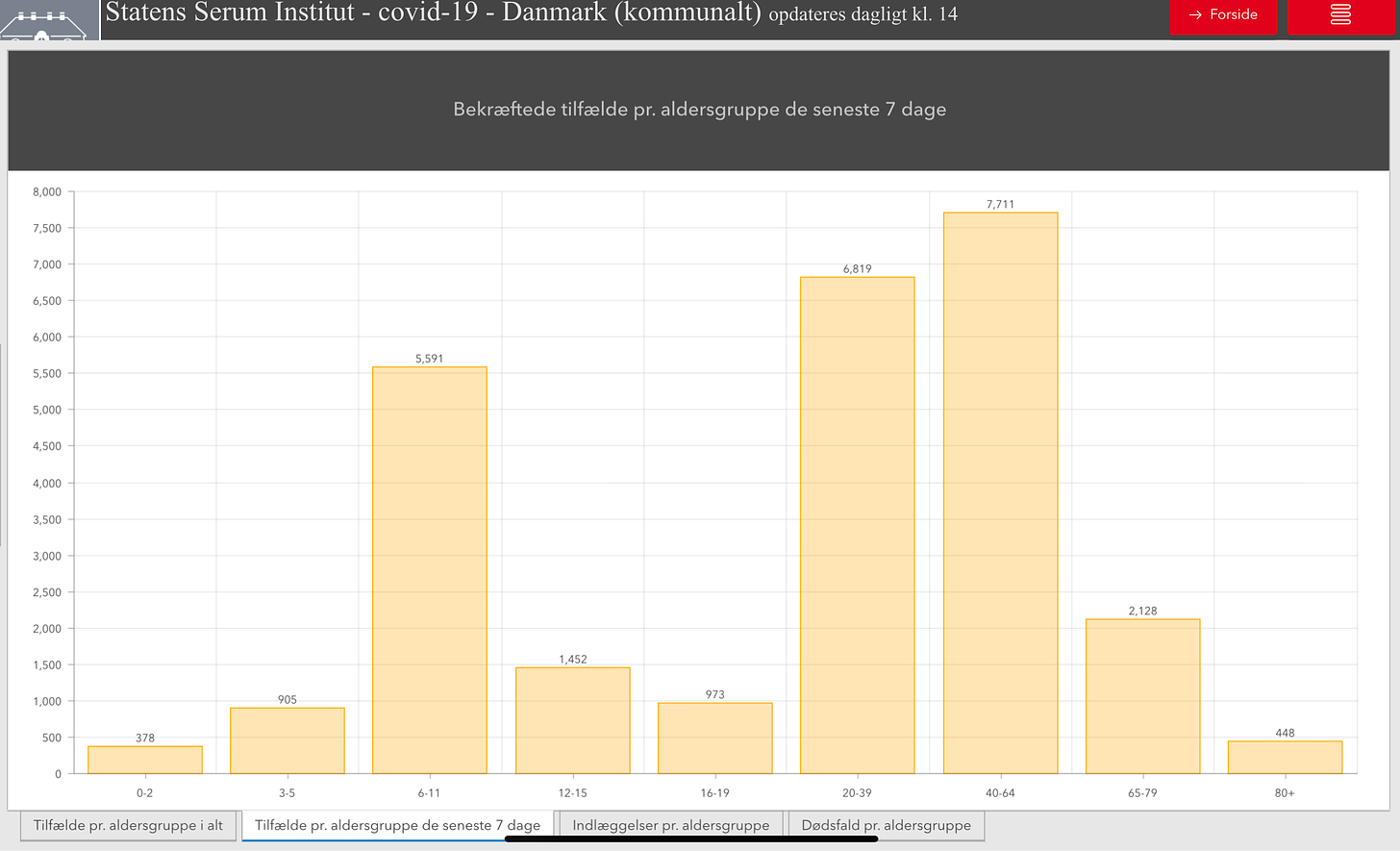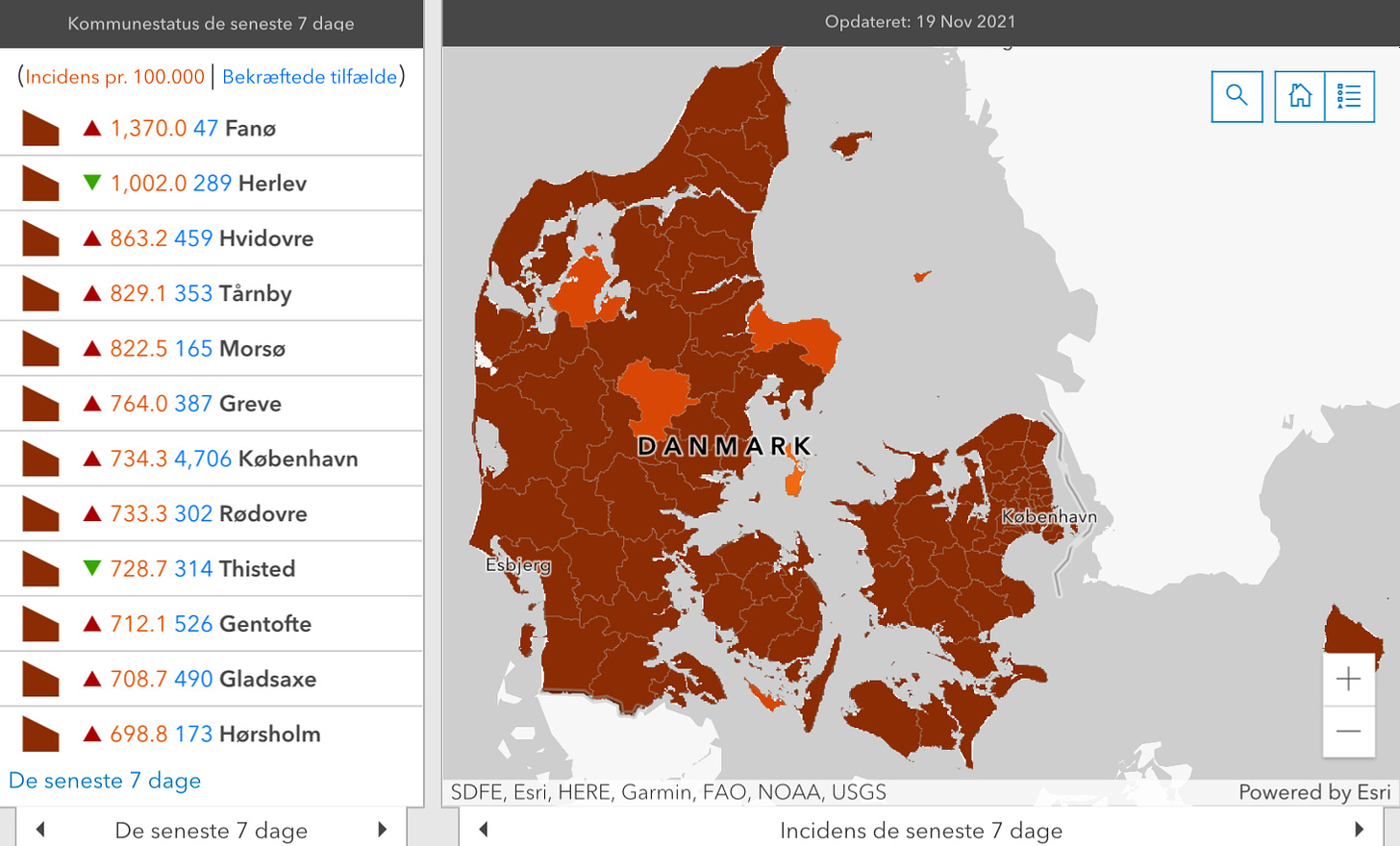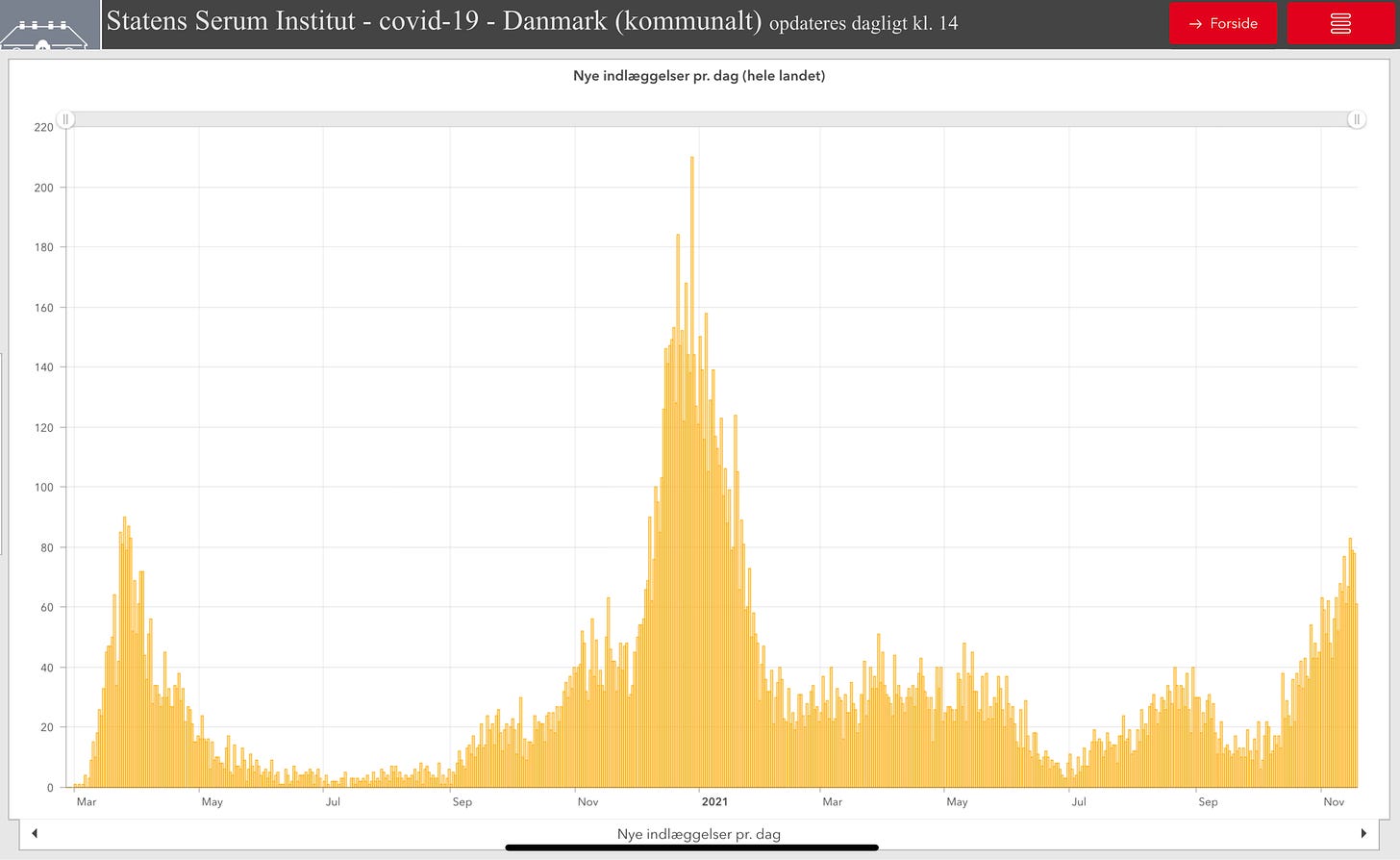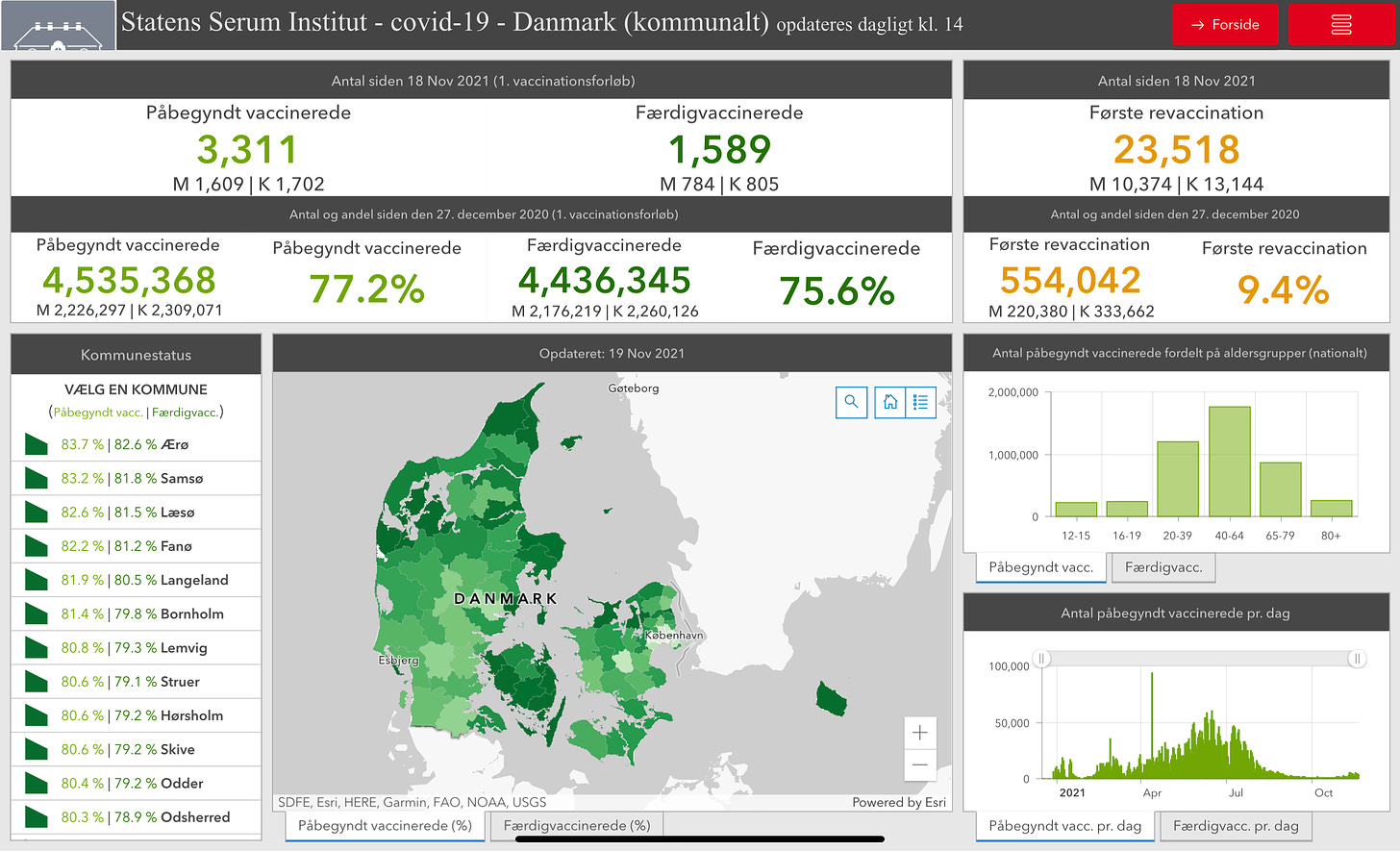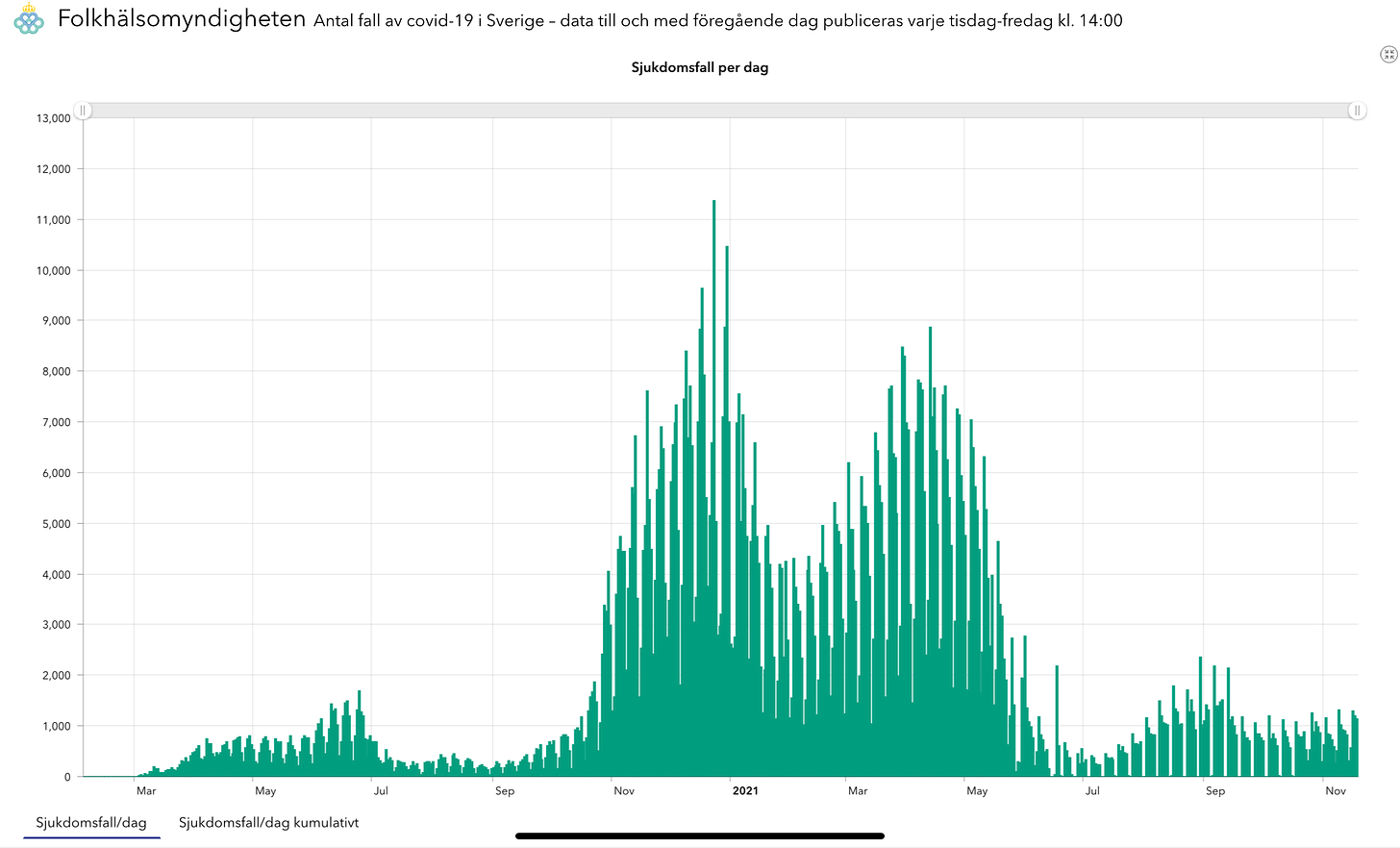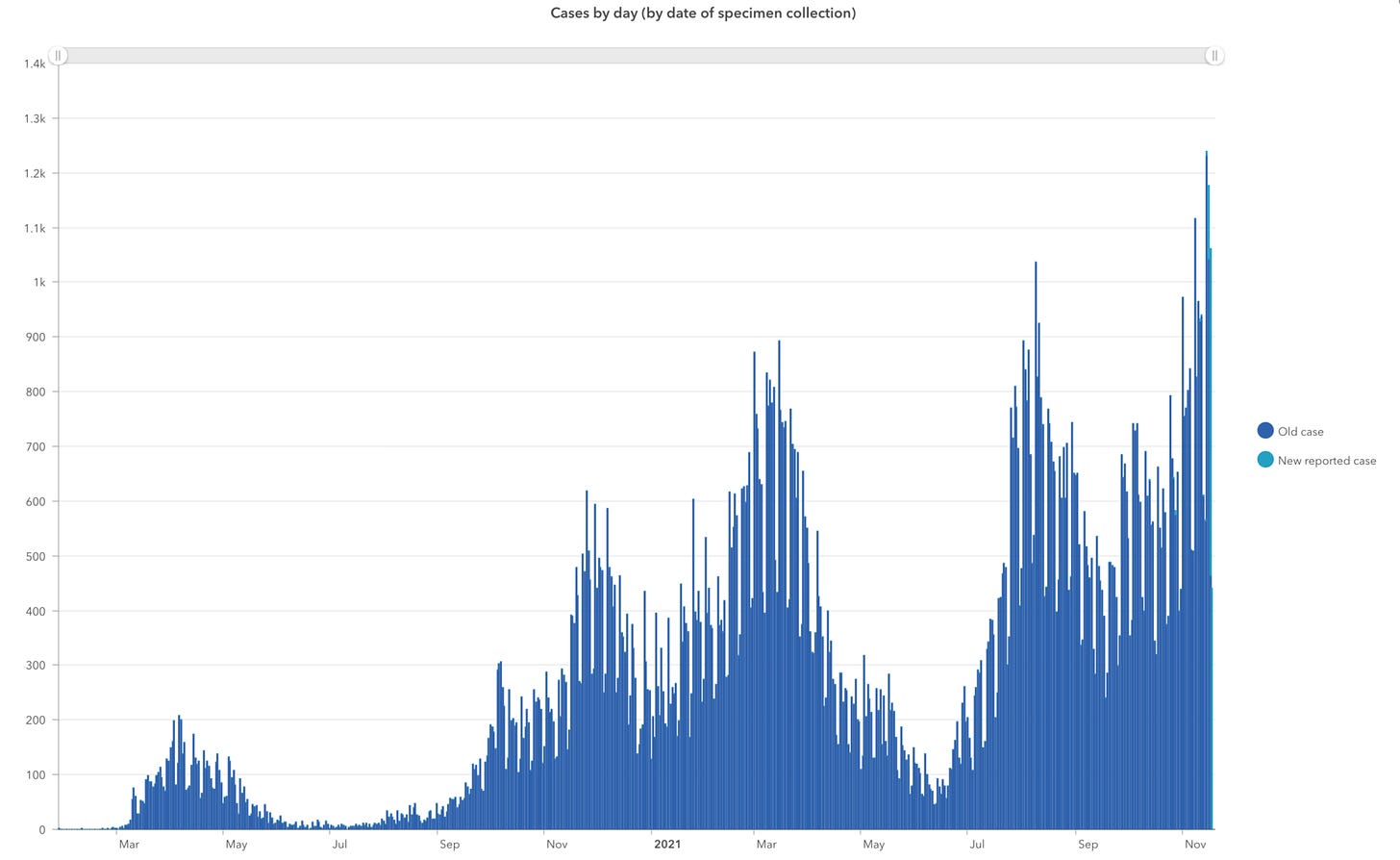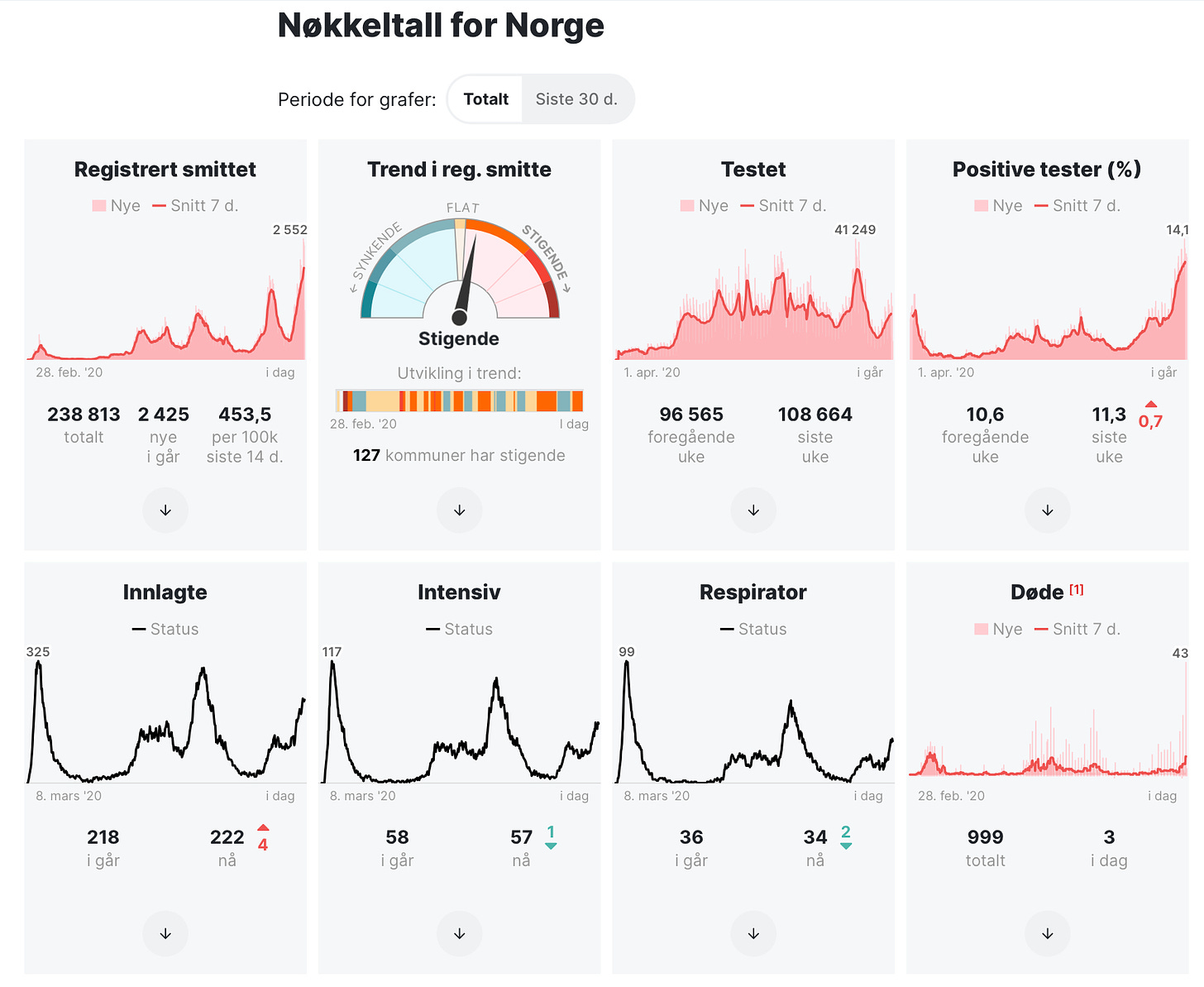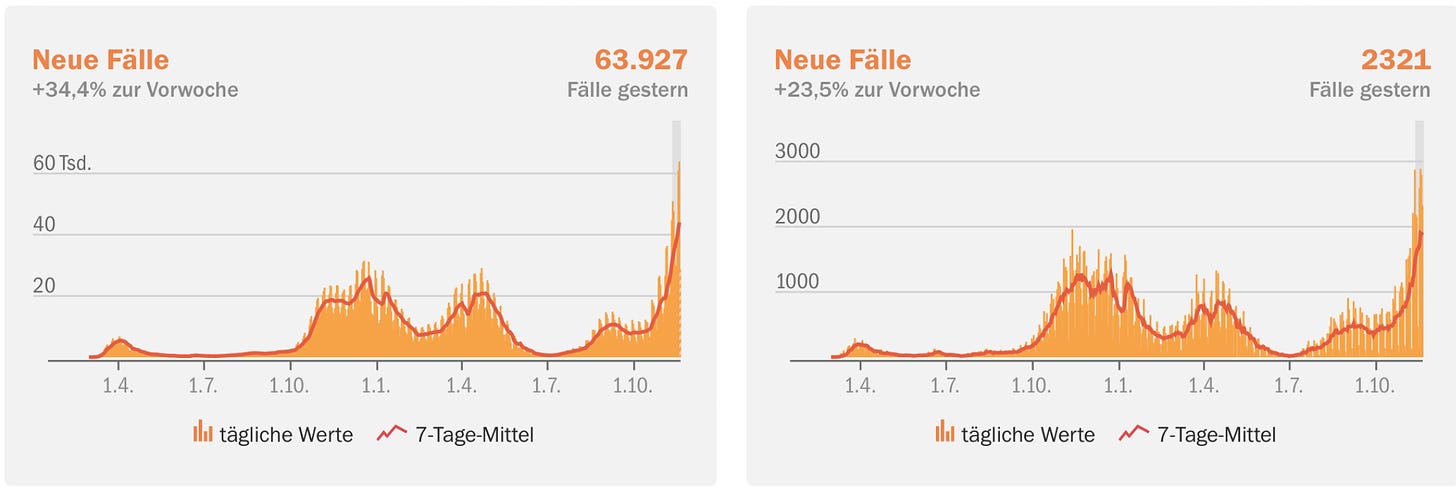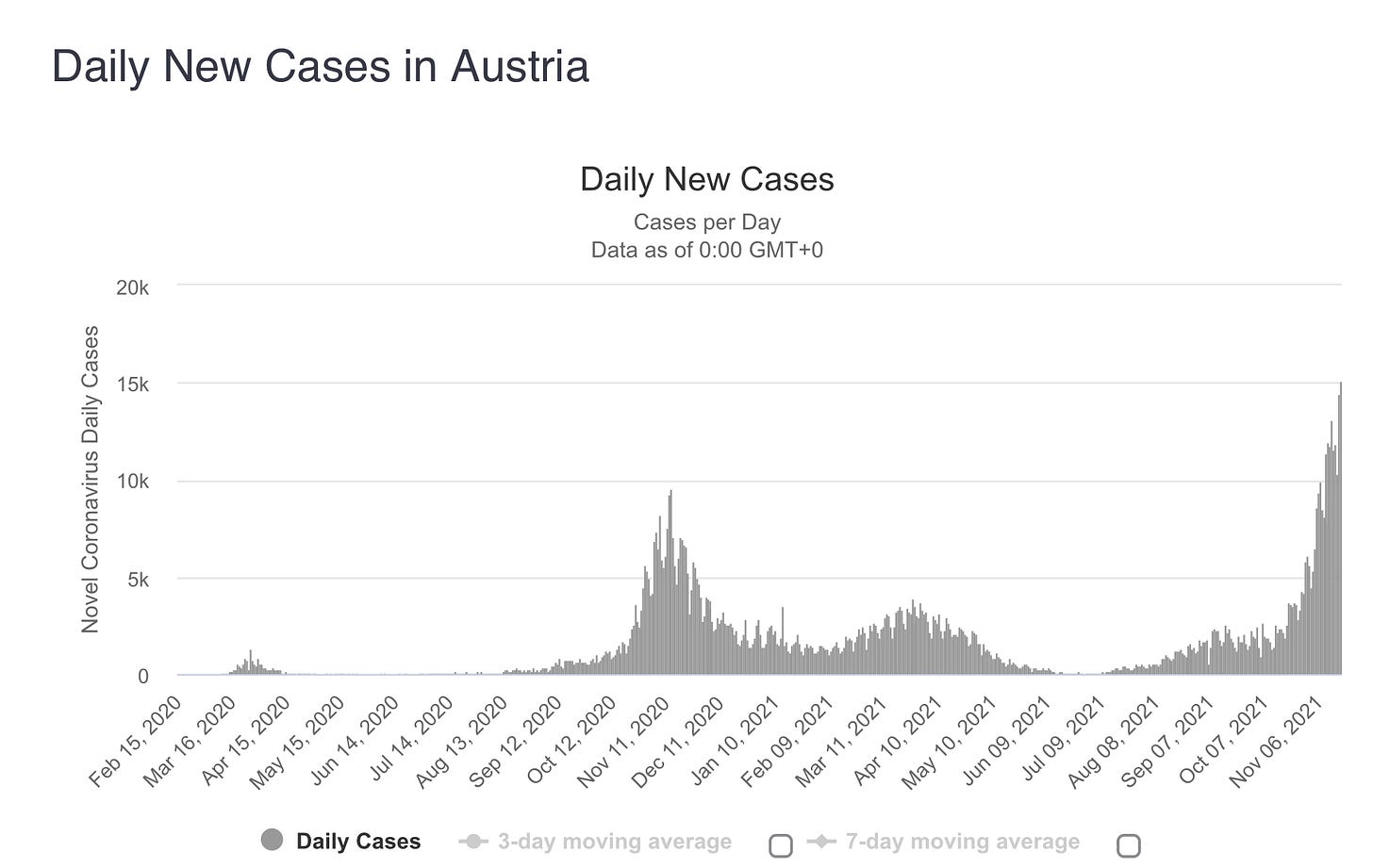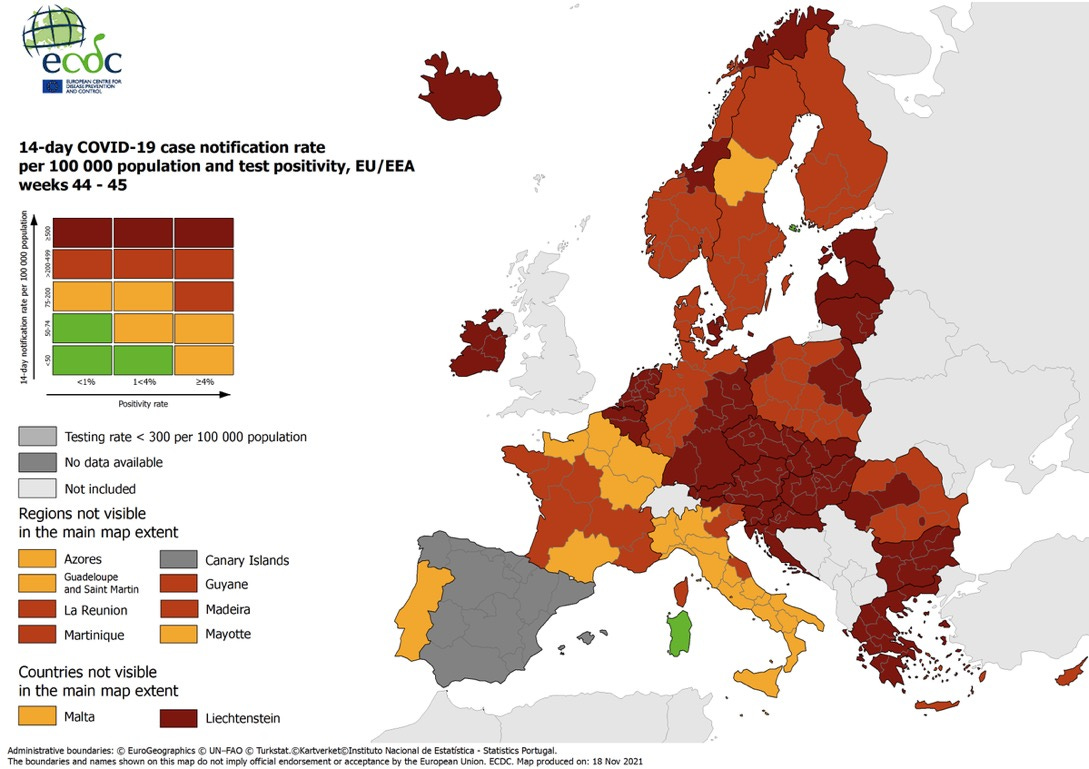The Evening Report - Nov 19
Denmark takes a small step to counter soaring infection among children
🇩🇰
The Staten Serum Institut says COVID cases among school age children in Denmark are now at the highest level of the entire pandemic. The SSI says coronavirus incidence rates are highest among children six to 11 years old with a jaw-dropping COVID incidence rate of 1,328 per 100,000. Infections are also very high among unvaccinated 12 to 15 year olds.
Infection, Epidemiology, and Prevention Physician Rebecca Legarth:
“It is clear that it is the children who are carrying the bulk of the infections right now, and we also see that they are bringing it further into their families and close contacts. So even though the children may not get seriously sick from COVID people close to them can.”
In a press conference on the epidemic situation on Friday Danish Agency for Patient Safety Director Anette Lykke Petri said there are 221 schools across Denmark that are dealing with major infection outbreaks.
“It is realistic that we are going to see more schools closed.”
Currently, classes have been closed at seven schools in Denmark due to significant coronavirus outbreaks. Tjørnegårdsskolen in Gentofte is the latest to be told to send students home.
In the press conference, Danish Health Minister Magnus Heunicke says weekly COVID testing will be introduced for school age children.
“Weekly rapid tests must now, in collaboration with municipalities, be offered to children all the way down to 1st grade. Of course, this must be done with the consent of the parents, but I urge parents to allow their children to get tested so that we can better control infection spread.”
The European Medicines Agency is currently assessing an application from Pfizer BioNTech to expand use of its COVID vaccine to children five to 11 years old in Europe. The EMA said yesterday a decision could come by as early as next week. When it does, Heunicke says, Denmark will be ready.
“If they do, then we have the setup ready.”
-
Denmark is reporting 4,070 COVIDinfections and five more #coronavirus deaths in the last day. This is the highest number of new infections since December 18. It also marks the 2nd day in a row, and 4th day ever in the pandemic, where daily corona cases have exceeded 4,000.
Yesterday there were 334,927 corona tests, of which 180,466 were PCR tests equaling a positivity percentage of 2.25%.
-
The Staten Serum Institut is warning that infection activity continues its upward march across the country. The agency says the number of new daily infections is well above levels seen at the same point a year ago. It says the number of COVID cases “has increased significantly” since mid-September and continues to spiral upward. It says infections increased by 42% from week 43 to 44.
The positivity percentage also continues to rise, going from 2.5% to 2.7% from one week to the next. While the capital region is the hardest hit, the Staten Serum Institut notes coronavirus cases are rising elsewhere in Denmark, but especially in North and Central Jutland.
-
Just five of Denmark’s 98 kommunes have a coronavirus incidence rate under 200 per 100,000 residents.
-
Data from the Staten Serum Institut shows that rising infections across the country are spilling over into the healthcare system. Among hospital staff there were 1,200 COVID infections last week.
-
After two days of a slight easing of hospital admission numbers COVID hospitalizations (378) leapt back upward again (+16) while the number of infected people in an ICU (48) edged downward (-2) and of those the number on a ventilator (24) also dropped slightly (-2).
National Board of Health Deputy Director Helene Probst is warning that the hospital system is under strain and overall is very “tired” after being under non-stop pressure for almost two years. Not to mention the backlogs and stress from the recent nurses labour dispute. She is asking people to get vaccinated and do every they can to keep themselves and everyone around them safe in order to prevent more hospitalizations.
SSI Director Henrik Ullum is also concerned about COVID hospitalizations saying the recent surge in admissions is “is a real problem.” Ullum says there were 80 coronavirus patients when the fall began and since then numbers have “have more than quadrupled in a short period of time.”
-
On the vaccination front, the number of 1st doses yesterday (3,311) remained elevated. There were 28,418 total inoculations on Thursday, with booster shots again dominating daily numbers.
To date, 77.2% of the total population have one dose, 75.6% have two, and 9.4% have had a booster shot.
-
Danish Agency for Security of Supply Director Lisbet Zilmer-Johns touted the major scaling up of Denmark’s COVID testing capacity in the last few weeks. Overall daily testing capacity has been increased to 370,000 tests per day.
“There is at least one rapid testing site and one PCR test site in every municipality. Right now we are experiencing in some places lines that are too long to get a PCR test. The regions are currently working to improve this.”
This is certainly the case in Region Syddanmark who warned people to brace for long lines at PCR testing sites as overall demand goes through the roof.
Executive Vice President Kurt Espersen:
“A few weeks ago we tested very, very few people. Now testing demand has exploded, and of course we are trying to adapt to that. It requires a lot more staff and they are not as easy to recruit as they used to be. We are doing everything we can, but there will be citizens who will experience long lines.”
The demand is partly due to the reimposed coronapas as well as the rising infection situation. For the Southern Denmark health authority this is especially true in the largest city in the region, Odense. The city is being hit hard by COVID infections and the municipality has asked the city’s 200,000 or so residents to go get tested.
“Of course it puts even greater pressure on our testing sites in the city. The fixed locations are in the process of still gearing up. We are also moving more mobile PCR testing sites into the city and Carelink is also opening a new test site. So we do what we can, but I also think we find it hard to completely avoid queuing when so many are suddenly asked to be tested.”
As for the situation in Odense, the municipality has a COVID incidence rate of 471 per 100,000 residents. This means it is required to take a number of local measures to try and reduce infection spread. The Kommune says infections are highest in the districts of Agedrup, Dalum, and Korsløkke.
COVID infections are spreading among children and young people in Odense in particular. The Kommune notes there are reported infection outbreaks in 23 of the city’s schools.
Mayor Peter Rahbæk Juel:
“The increase in infections is worrying but is not just us as the trend is prevalent throughout the country. That is why we are focusing on fighting infection spread. From today, further initiatives will be launched, especially where it concerns children and young people, where the outbreak is greatest. But there will also be an increase among 16- to 18-year-olds. Our focus is on bringing the infection down again as soon as possible, so we can avoid even more restrictions.”
Among local measures that have been implemented so far, classes in schools and daycares are not to mix with other classes. All major school-organized social events are cancelled. Parents and school staff have to maintain social distancing as much as they can. This includes parents picking up and dropping their kids off without going inside the school.
-
Denmark’s booster shot campaign is about to shift into a higher gear. Health Minister Magnus Heunicke said today that another 450,000 invitations will go out today for people to book an appointment to get a 3rd vaccine dose. This will push the overall number of revaccination invitations sent out to date to 1.5 million.
Deputy Director of the National Board of Health Helene Probst says people should expect to hear plans from the authorities next week on administering booster shots to people under the age of 65.
-
Get your coronapas ready because you will probably need it to go to work fairly soon. In today’s COVID press conference Health Minister Magnus Heunicke said the government is poised to pass legislation allowing companies and businesses to mandate employees show their coronapas to come to work. The requirement could also extend to government workers as well.
“At the same time, we as a government are prepared to introduce a coronapas requirement in government workplaces.”
For its part, the association representing local governments, KL, is now encouraging municipalities to “set requirements for the coronapas for employees in nursing homes and social housing and to consider requiring a coronapas in a number of areas where there is interaction with citizens.”
For unvaccinated people in Denmark, they could soon find it challenging to head to work. If their employer doesn’t ban them entirely from physically coming to work, it will mean frequent weekly testing will become a regular part of the work week.
Heunicke indicated today that the length of time a negative test is considered valid will likely be shortened.
“I will ask the Epidemic Commission to investigate whether the validity of a negative test in a coronapas should be valid for a shorter period of time, because you can still get infected and then infect others during a period when the passport is still valid.”
If the Epidemic Commission agrees with the health minister, then the change must be approved by the Danish parliament’s Epidemic Committee.
-
The other big message from today’s COVID press conference was to use common sense for seasonal julefrokosts (Traditional Danish Christmas lunch parties). The Deputy Director for the National Board of Health Helene Probst, says this year’s julefrokost’s “will be slightly different than usual.”
Probst advises attendees to be vaccinated. If anyone is sick, they should stay home. The space should be well ventilated. Companies should also work to ensure there is enough space to abide by social distancing. She also suggests keeping the drinking in check.
🇸🇪
Sweden has added 1,128 infections and one more coronavirus death since yesterday’s update.
To date, 7,289,691 1st vaccine doses (85.3% of the population 16 years old and older) and 6,992,273 2nd doses (81.9%) have been administered.
Vaccination statistics for 12 to 15 year olds and for booster shots have not updated.
-
In Sweden, the rush is on to get digital vaccine passports onto smart phones and devices. After the Swedish Public Health Agency asked the government to implement a vaccine passport system by December 1 it has triggered a minor stampede online. The Swedish E-Health Authority says on Wednesday 181,388 people went online to retrieve their vaccination certificates. On Thursday, another 147,480 people followed suit. Over the Wednesday and Thursday of the week before, the numbers were 2,873 and 2,706, respectively.
The Swedish government is proposing to introduce a vaccine passport on December 1 that would apply to all indoor public events and all public gatherings for everyone 18 years old and older.
🇫🇮
Finland registered 1,191 infections and three more corona deaths in the last day.
COVID hospitalizations (277) have dropped (-22).
So far, 75.9% of the total population have one vaccine dose, 71.1% have two, and 2.9% have had a booster dose.
-
The Finnish Institute for Health is now recommending that anyone in close contact with vulnerable populations and people at risk have a booster dose. It also recommends a 3rd vaccine dose should also go to health and senior care staff.
“Mild or asymptomatic infections among healthcare staff could cause a risk of infections among patients at risk of serious Covid infections that they care for.”
The health agency says vaccine supplies remain robust enough to handle both booster doses and continues efforts to get a first and second dose to the wider population.
The health institute says it will table its recommendations on administering booster shots to the general public in a matter of weeks.
🇳🇴
Norway has added 2,445 infections and three more virus deaths in the last day.
COVID hospitalizations (222) have edged up (+4) while the number of infected people in an ICU (57) is down (-1) of those the number on a ventilator (34) is also down (-2).
So far, 78.41% of Norwegians 12 years old and older have had one vaccine dose and 70.30% have had both.
-
Norway is tightening border restrictions as infections skyrocket. As of November 26, all incoming travelers will have to register to enter the country. Previously fully vaccinated trackers had been exempt but no longer. This does not apply to children under the age of 16. Registration must be down within three days of departing on your trip to Norway. Travelers must print off a confirmation of registration and be prepared to show it at the border along with their coronapas.
Anyone who is not fully vaccinated, who has had a recent infection, or anyone holding a vaccine passport or other proof of vaccination not recognized by Norwegian authorities must have a negative test to cross the border. The negative test cannot be any older than 24 hours. Young people under the age of 18 are exempt.
Current quarantine rules remain unchanged and quarantine hotels will be available to anyone who must isolate but does not have a suitable place to quarantine after arrival.
🇩🇪
The COVID situation is so dire in Germany that both Health Minister Jens Spahn and the Head of the Robert Koch Institute Lothar Wieler, are describing the situation as “a national emergency.” Spahn also wouldn’t rule out imposing another national lockdown.
Wieler for his part, is painting a grim picture as he says hospitals are at the breaking point.
“We need to pull the emergency brake now. We need to turn the tide. There's really no time to lose."
In just two weeks, the number of new coronavirus infections has increased by more than 60%. On Friday, the country reported another 52,970 infections after setting new record highs multiple times in the last week.
The Secretary-General of the German Society for Internal Intensive Care, Uwe Janssens, told DW News Germany’s COVID situation is “absolutely worrying.” Janssens is very concerned about hospitals noting the lag between soaring infections and a subsequent surge in hospitalizations. He says the situation is becoming “too much to handle.”
“In the south of Germany, in Bavaria, Saxony, and Baden-Württemberg and other areas, the hospitals and even the intensive care units have such a high pressure, such a high load that in some regions there are zero free intensive care unit beds. So we have to postpone planned operations."
Janssens isn’t alone as the health minister is also saying Germany’s is on the verge of taking unprecedented action. Spahn says Germany may have to begin transferring COVID patients either to other regions with hospital capacity or to nearby countries who can take them.
-
All Christmas markets in the German state of Bavaria have been canceled due to the COVID situation.
-
In Berlin Mayor Michael Müller didn’t sugarcoat his words in addressing those who have not yet been vaccinated.
“It is not because there hasn’t been enough public information in recent months. It is not because there wasn’t enough advertising or insufficient vaccinations, insufficient infrastructure, not enough money, or too few vaccines, or a lack of determination. That is not the reason. The reason is that there is too much selfishness and too much indifference. That in fact, some still believe that within a community their behavior does not count.”
🇦🇹
As of Monday, it won’t just be the unvaccinated under a lockdown in Austria as the country will begin its fourth national lockdown. It will last at least ten days. The number of COVID infections is skyrocketing in the country.
With 69.3% of the population fully vaccinated, Austrian Chancellor Alexander Schallenberg revealed his government is also looking at compulsory vaccinations for the population.
“Despite months of persuasion, discussions, and a range of efforts, we have not succeeded in getting enough people vaccinated. We have to look reality in the eye.”
The Austrian government is now seeking counsel on whether mandatory vaccinations are legal, or not. If all the boxes are checked off, then Schallenberg says a vaccine mandate would be introduced in February. There are still lots of questions about how a mandate like that would work, but several Austrian media outlets are reporting it might be backed with stiff fines and prison time.
If successful, Austria would be the first country in Europe to mandate COVID vaccinations at the population level.
On Friday Austria reported 15,809 new cases and 48 new deaths.
🇪🇺
The European Medicines Agency is giving its okay to member countries to use a COVID treatment pill pioneered by Merck on an emergency use basis. This is despite the pill not yet having been approved for use. On Friday the agency issued recommendations to EU countries that will act as guidelines should the epidemic get so bad emergency measures need to be taken.
"The EMA has issued this recommendation so that national authorities can make a decision regarding the early use of the medicine before it is approved for marketing,"
In Denmark, 450 million kroner has been earmarked over the next two years to purchase the pills from Merck.
-
Here is the latest COVID risk assessment map from the European Centre for Disease Prevention and Control.
🇨🇦
Health Canada has approved an application from Pfizer BioNTech to expand its vaccine to children five to 11 years old. The first batches of the special pediatric vaccine doses will arrive in Canada on Sunday. Public Services and Procurement Minister Filomena Tassi says Pfizer will ship more than 2.9 million doses to Canada by the end of next week. This means children can begin to be vaccinated by as early as next week.
Health Canada says children will need two doses spaced three weeks apart but the National Advisory Committee on Immunization is recommending two doses taken at least eight weeks apart, citing studies showing longer intervals, result in a more robust immune response.
-
The Canadian government has made it official. Beginning November 30 Canadian citizens and permanent residents will no longer be required to show a PCR negative test result to return to Canada from short trips abroad. The requirement is dropped for people who are out of the country for 72 hours or less.
-
Canada will also require all essential workers, which includes truck drivers and professional athletes to be fully vaccinated to enter the country. The requirement will come into force on January 15, 2022.




